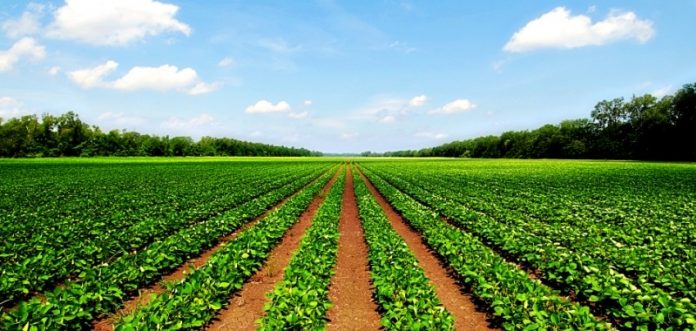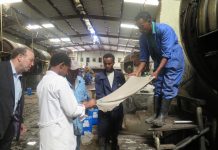Rural-urban food supply chains are developing rapidly to meet urban demand.
The post-farmgate segments of the supply chain—the midstream segment (processing and wholesale/transport) and downstream (retail and food stalls)—together form 50-70 percent of food costs to urban Africans. That means that these actors are as important as farmers for national food security.
Where this post-farmgate supply chain has failed or been constrained, this has blocked the success of well-designed rural and crop development efforts, such as a famous case where cowpea production in Senegal was promoted by government, non-government organization, and donor efforts, but the cowpeas rotted on the side of the road for lack of a link to market.
By contrast, we have found that—seemingly largely “under the radar” of the development debates—there is emerging a “Quiet Revolution” in supply chains, with tens of thousands of small and medium-scale enterprises (SMEs) in trucking, wholesale, warehousing, cold storage, first and second stage processing, local fast food, and retail, making major investments in recent years!
We have been surprised to see how similar this is—and similarly not yet central in the national debates—to what we recently observed in Asia (often occurring just in the past five to seven years), which is somewhat ahead of Africa, but going in the same direction of grass-roots revolution supply chains.
Exciting examples have been cited to illustrate explosive growth in only five to ten years:
Teff in Ethiopia: An explosion of growth has occurred in only the past five to ten years in the teff value chain to Addis Ababa, with the proliferation of SME mills-cum-retailers in Addis and rapid transformation all along the teff supply chain leading to: (i) increasing adoption of modern inputs (chemical fertilizer, improved varieties, and herbicides) by farmers, especially by those living close to urban centers; (ii) rising quality demands and important shifts from the cheap red varieties to the more expensive white ones; (iii) increasing willingness-to-pay by consumers for convenience in urban areas, with rapid emergence of one-stop retail shops that provide sales, cleaning, milling, and transport services, as well as by a sizable foodservice industry; (iv) the share of rural–urban marketing, urban distribution, and milling margins in final retail prices is declining, indicating improved marketing efficiency over time.
Wheat and maize flourmills, wholesale markets, and transport SMEs in Ethiopia. In the past decade there has been an explosion of growth in private commercial flour mills in Ethiopia. Until the early 1990s, all commercial flourmills were owned by the government and there were no private sector-owned flourmills; private mills started to emerge in the early 2000s. By 2008, there were 65 large commercial flourmills, together milling about 30% of marketed grain; a third of these mills are in Addis.
The government built a new modern wholesale market outside the city (the Ashwa Meda market). It is estimated that a significant part of the cereal trade has been diversified to this wholesale market. Existing markets have also often expanded. In a study on dynamics of cereal wholesale markets in Ethiopia over the last decade, focus groups reported that the number of the trucks increased over the ten-year period by 67 percent and 79 percent in the peak period and lean period, respectively. The number of traders and brokers that operate on these markets also increased significantly. They were reported to have increased by respectively more than 100 and 200 percent over that period, possibly suggesting increased trade as well as greater competition and lower turnover per trader and broker compared to ten years ago.
SME maize processors in Kenya, Zambia, and Zimbabwe. Over the past two decades there has been the emergence of thousands of SMEs, driving down maize processing margins.
Fertilizer SMEs in Kenya. Fertilizer market liberalization in the early 1990s initiated the rapid emergence of SMEs in the fertilizer supply chain, with 500 fertilizer private wholesalers and 7000 fertilizer private retailers by 2008 inducing a 50 percent fall in fertilizer marketing margins and a 60 percent decrease in distance from farms to fertilizer retail points over the 1990s and early 2000s.
Millet value chains in Senegal. There has been a rapid transformation in the millet supply chain in Senegal with the rise in the past five years of branded packaged millet and millet-cum-dairy products for the Dakar market (importantly in supermarkets as drivers of demand for this) and even into export markets.
Chicken supply chains in Nigeria and Mozambique. There has been a rapid transformation of the chicken supply chain into urban Nigeria with the rise of companies like Zartech, which in turn link to small farmers; and into urban Mozambique with a wide range of local and regional poultry companies.
Sorghum beer brewing SMEs in Southern Africa. There has been a rapid rise and transformation of the sorghum beer market with backyard brewers transforming into wide-ranging small and medium companies in several countries in Africa. Note that government investment in food technology research was important to this transformation, with South Africa’s Council for Scientific and Industrial Research CSIR) playing a key role in study of sorghum malting and brewing, enabling factory brewers to scale up production to industrial scale.
Dairy-related SMEs in Kenyan and Zambia. There has been a rapid rise of dairy input and processing companies, linked to small farmers, in Kenya and Zambia in the past decade. SMEs have emerged to supply improved feeds, artificial insemination and veterinary services, and processing and packaging facilities and in raw milk distribution systems.
SMEs processing cassava in Nigeria and Ghana. There has been a rapid rise of gari/cassava and palm oil small and medium companies in Ghana and Nigeria; today, SME’s (traders, artisans, food processors) sales of gari (pre-cooked convenience food from cassava) constitute half of cassava output in West Africa; in turn, cassava is the largest single source of calories in West Africa; during the 2000s, as hand peeling has become an increasing bottleneck to growth, private cassava processors have adapted continuous-flow abrasion systems used in European potato starch-processing equipment to automate and scale up cassava processing to 5 tons per hour. Moreover, there is new initiative by the Nigerian government to support small/medium second stage processors of cassava.
Horticultural product processing SMEs in Rwanda. There has been an explosion of SMEs in fruit and vegetables processing and trading in Rwanda in the past decade, for the local and the regional market.
We think these rapidly emerging agrifood SMEs are often neglected (the “ignored middle”) in the African food debate. They have long thought by researchers and policymakers to be a negligible group, too small a force to count; this perception has gone along with laments from governments and donors of the lack of African grass-roots investments. This widespread view was largely responsible, we think, for turning attention to seeking investment from either parastatals or to multinationals, rather than rely on grass-roots local firms to invest.
But, we find (as in the ten cases above) that there is a surge in African grass-roots companies investing in wholesale, trucking, processing, and storage, and in the medium-long run we think that as in Asia, these will form the backbone of the Quiet Revolution in food systems in Africa. A number of the emerging and already established small and medium food firms will also develop into Africa’s Lions in the global food arena, large private companies that will be region-wide and eventually important globally. They will be key to African competitiveness.
However, in the words of Ousmane Badiane, these rapidly emerging supply chain actors are only “flying at 20 percent of their potential altitude.” They urgently need major attention to resolve hard and soft infrastructural bottlenecks they face, such as rural wholesale markets, industrial-strength electricity grids, surfaced roads; and regulation and policy reforms to improve their “business climate.”
Thomas Reardon Ph.D., David Tschirley Ph.D., Steven Haggblade Ph.D., and Saweda Liverpool-Tasie Ph.D. are professors in the Department of Agricultural. Food and Resources Economics at Michigan State University; Bart Minten is a senior research fellow at the International Food Policy Research Institute: and Charles Peter Timmer is the Thomas D. Cabot Professor of Development Studies, emeritus, Harvard University. The above is excerpted from their brief prepared for the high-level dialogue on “Harnessing Innovation for African Agriculture and Food Systems: Meeting Challenges and Designing for the 21st Century,” that took place November 25-26, 2013, at the African Union Conference Center in Addis Ababa, Ethiopia. It was presented in Ethiopia by Prof. Reardon (pictured)













